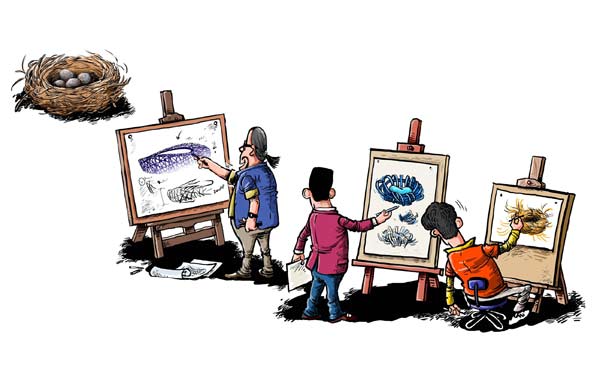The Chinese obsession with reproducing elements of the existing world can lead to a flight of imagination or to a self-imposed cocoon of shoddy cloning.
 |
| Pang Li / China Daily |
The Chinese have a weakness for imitation, which is not only the sincerest form of flattery, but also, in the deepest recesses of our collective unconscious, a display of subjugation to nature or the outside world. A recent photo of what turns out to be a greenhouse in a county of Jiangsu province has turned heads for its eerie similarity to the Sydney Opera House. Why that landmark by Sydney harbor, out of all the famous buildings in the world? I ask myself. Well, most Chinese love it because it is said to resemble a cluster of open seashells.
You may say we Chinese tend to be literal-minded. We simply love to associate man-made structures with objects that already exist in the physical world. In Beijing alone, the Olympic Stadium is called "the Bird's Nest", which inevitably spawned scaled-down look-alikes across the country. The National Center for the Performing Arts was nicknamed "the Giant Egg", a moniker that has lost much of its appeal ever since the center opened.
The new CCTV building has been widely known as "the Big Pants", which its future occupants are uncomfortable with since the lower body has much to hide. And the new People's Daily building is so stridently phallic in shape even those who consider themselves open-minded couldn't help dropping their jaws in hushed gasps.
All these examples are associations made in hindsight by the public, which may or may not have been the intention of the designers. We also have buildings that were conceived to be copies of the real thing. For example, a hotel in a Beijing suburb is shaped like the three immortals from a Chinese legend, with patterns on their robes functioning as windows, and there are a couple of structures that are virtual statues of the Wuliangye brand of liquor bottle, with and without the packaging. Many of these buildings have made the list of the tackiest or ugliest both in China and overseas.
I can imagine the argument of the Wuliangye executives who hit upon the idea: "Why do you say the Bird's Nest is a good-looking structure and ours is not? We used the same principle in design." Yes, indeed, if the designers of the stadium had a nest in mind. The difference is, the stadium designers could be inspired by some physical object and were able to rise above it, while the brewery was so slavishly loyal to its liquor bottle it was nothing more than an enlarged carbon copy. I have seen buses wrapped around with advertising that's more tasteful than that.
Before the Chinese landscape became cluttered with high-rises of all configurations, we were busy assigning descriptive names to mountain peaks and rock formations. When you cruise down the picturesque Lijiang River in Guilin, you will encounter the Yellow Cow, the Giant Carp that also reminds one of a puppy, the Eight Immortals, the Nine Horses, the Yellow Cloth, the Drum and the Gong, and so on. A smart tour guide would encourage you into a guessing contest, the result of which can now be easily recorded on your cellphone camera and brought home for verification.
